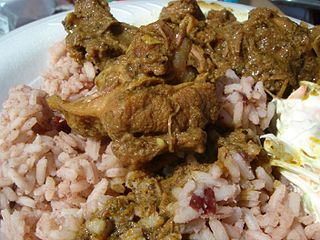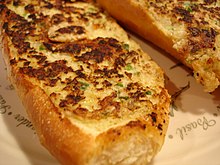
Nasi lemak is a dish originating in Malay cuisine that consists of fragrant rice cooked in coconut milk and pandan leaf. It is commonly found in Malaysia, where it is considered as the national dish. It is also a native dish in neighbouring areas with significant ethnic Malay populations such as Singapore and Southern Thailand. In Indonesia, it can be found in several parts of Sumatra, especially the Malay regions of Riau, Riau Islands and Medan. It is considered an essential dish for a typical Malay-style breakfast. Nasi lemak is featured as a national dish in most of the country's tourism brochures and promotional materials.

Roti is a round flatbread native to the Indian subcontinent. It is commonly consumed in many South Asian, Southeast Asian, Caribbean, and Southeast African countries.

Malay cuisine is the traditional food of the ethnic Malays of Southeast Asia, residing in modern-day Malaysia, Indonesia, Singapore, Brunei, Southern Thailand and the Philippines as well as Cocos Islands, Christmas Island, Sri Lanka and South Africa.

Singaporean cuisine is derived from several ethnic groups in Singapore and has developed through centuries of political, economic, and social changes in the cosmopolitan city-state.

Motabbaq is a stuffed pancake or pan-fried bread which is commonly found in the Arabian Peninsula, the Indian subcontinent and Southeast Asia, notably in Saudi Arabia, Yemen, Indonesia, Malaysia, Singapore, Brunei and Southern Thailand. Depending on the location, the name and ingredients can significantly vary. The name mutabbaq in Arabic means "folded". It is a popular street food in Yemen, Indonesia, Malaysia, Thailand and Singapore.

Goat curry, curried goat, or curry goat is a curry dish prepared with goat meat, originating from the Indian subcontinent. The dish is a staple in Southeast Asian cuisine, Caribbean cuisine, and the cuisine of the Indian subcontinent. In the Caribbean and Southeast Asia, the dish was brought to the region by the Indian diaspora, and has subsequently influenced the respective local cuisines. This dish has also spread throughout the Indo-Caribbean diaspora in North America and Europe.

Fried noodles are common throughout East Asia, Southeast Asia and South Asia. Many varieties, cooking styles, and ingredients exist.

Fish head curry is a dish in Indonesian, Malaysian and Singaporean cuisines with mixed Indian and Chinese origins. The head of a red snapper is stewed in a Kerala-style curry with assorted vegetables such as okra and eggplants. It is usually served with either rice or bread, or as a shared dish.

Sup kambing or sop kambing is a Southeast Asian mutton soup, commonly found in Brunei Darussalam, Indonesia, Malaysia, Singapore. It is prepared with goat meat, tomato, celery, spring onion, ginger, candlenut and lime leaf, its broth is yellowish in colour. Sup kambing is quite widespread as numbers of similar goat meat soup recipes can be found throughout Malaysia, Indonesia and Singapore.

Padang dish or Minangkabau dish is the cuisine of the Minangkabau people of West Sumatra, Indonesia. It is among the most popular cuisines in Maritime Southeast Asia. It is known across Indonesia as Masakan Padang after Padang, the capital city of Western Sumatra province. It is served in restaurants mostly owned by perantauan (migrating) Minangkabau people in Indonesian cities. Padang food is ubiquitous in Indonesian cities and is popular in neighboring Malaysia and Singapore.

Malaysian Indian cuisine, or the cooking of the ethnic Indian communities in Malaysia, consists of adaptations of authentic dishes from India, as well as original creations inspired by the diverse food culture of Malaysia. Because the vast majority of Malaysia's Indian community are of South Indian descent, and are mostly ethnic Tamils who are descendants of immigrants from a historical region which consists of the modern Indian state of Tamil Nadu and Sri Lanka's Northern Province, much of Malaysian Indian cuisine is predominantly South Indian inspired in character and taste. A typical Malaysian Indian dish is likely to be redolent with curry leaves, whole and powdered spice, and contains fresh coconut in various forms. Ghee is still widely used for cooking, although vegetable oils and refined palm oils are now commonplace in home kitchens. Before a meal it is customary to wash hands as cutlery is often not used while eating, with the exception of a serving spoon for each respective dish.

Roti jala, roti kirai or roti renjis is a popular Malay and Minangkabau tea time snack served with curry dishes which can be found in Indonesia, Malaysia and Singapore. This is a very traditional Malay dish that is usually homemade and served at events such as weddings and festivals. It is usually eaten in sets of three to four pieces with curries, especially chicken curry, as a substitute to rice.

Roti canai, or roti prata, also known as roti chanai and roti cane, is an Indian flatbread dish found in several countries in Southeast Asia, especially Brunei, Indonesia, Malaysia, Singapore, and Thailand. It is usually served with dal or other types of curry but can also be cooked in a range of sweet or savoury variations made with different ingredients, such as meat, eggs, or cheese.

Paratha is a flatbread native to the Indian subcontinent, with earliest reference mentioned in early medieval Sanskrit, India; prevalent throughout the modern-day nations of India, Pakistan, Nepal, Bangladesh, Maldives, Afghanistan, Myanmar, Malaysia, Singapore, Thailand, Mauritius, Fiji, Guyana, Suriname, and Trinidad and Tobago where wheat is the traditional staple. It is one of the most popular flatbreads in the Indian subcontinent and the Middle East. Paratha is an amalgamation of the words parat and atta, which literally means layers of cooked dough. Alternative spellings and names include parantha, parauntha, prontha, parontay, paronthi (Punjabi), porota, paratha, palata, porotha, forota, farata, prata, paratha, buss-up shut, oil roti and roti canai in Malaysia and Indonesia.

Mamak stalls are indoor and open-air food establishments particularly found in Southeast Asia, especially in Malaysia and Singapore, which serve a type of Indian Muslim cuisine unique to the region and by its Indian community.

Acehnese cuisine is the cuisine of the Acehnese people of Aceh in Sumatra, Indonesia. This cuisine is popular and widely known in Indonesia. Arab, Persian, and Indian traders influenced food culture in Aceh although flavours have substantially changed their original forms. The spices combined in Acehnese cuisine are commonly found in Indian and Arab cuisine, such as ginger, pepper, coriander, cumin, cloves, cinnamon, cardamom, and fennel.

Arab Indonesian cuisine is characterized by the mixture of Middle Eastern cuisine with local Indonesian-style. Arab Indonesians brought their legacy of Arab cuisine—originally from Hadhramaut, Hejaz, Sudan and Egypt—and modified some of the dishes with the addition of Indonesian ingredients. The Arabs arrived in the Nusantara archipelago to trade and spread Islam. In Java, since the 18th century AD, most of Arab traders settled on the north coast and diffuse with indigenous, thus affecting the local cuisine culture, especially in the use of goat and mutton meat as well as ghee in cooking.

Indian Indonesian cuisine is characterized by the mixture of Indian cuisine with local Indonesian-style. This cuisine consists of adaptations of authentic dishes from India, as well as original creations inspired by the diverse food culture of Indonesia. Indian influence can be observed in Indonesia as early as the 4th century. Following the spread of Islam to Indonesia and trading, Muslim Indian as well as Arab influences made their way into Indonesian cuisine. Examples include Indian biryani, murtabak, curry and paratha that influenced Acehnese, Minangkabau, Malay, Palembangese, Betawi and Javanese cuisine.

Roti bakar, also known as roti kahwin, refers to a type of toast bread in maritime Southeast Asia, usually prepared with grilled white bread, in both the Indonesian and Malay languages. The dish is a popular breakfast food as well as tea time snack in countries like Brunei, Indonesia, Malaysia and Singapore. Historically, roti bakar was grilled or toasted by using charcoal as a heat source in many communities throughout the region, though this practice has dwindled with the advent of modern technology.





















